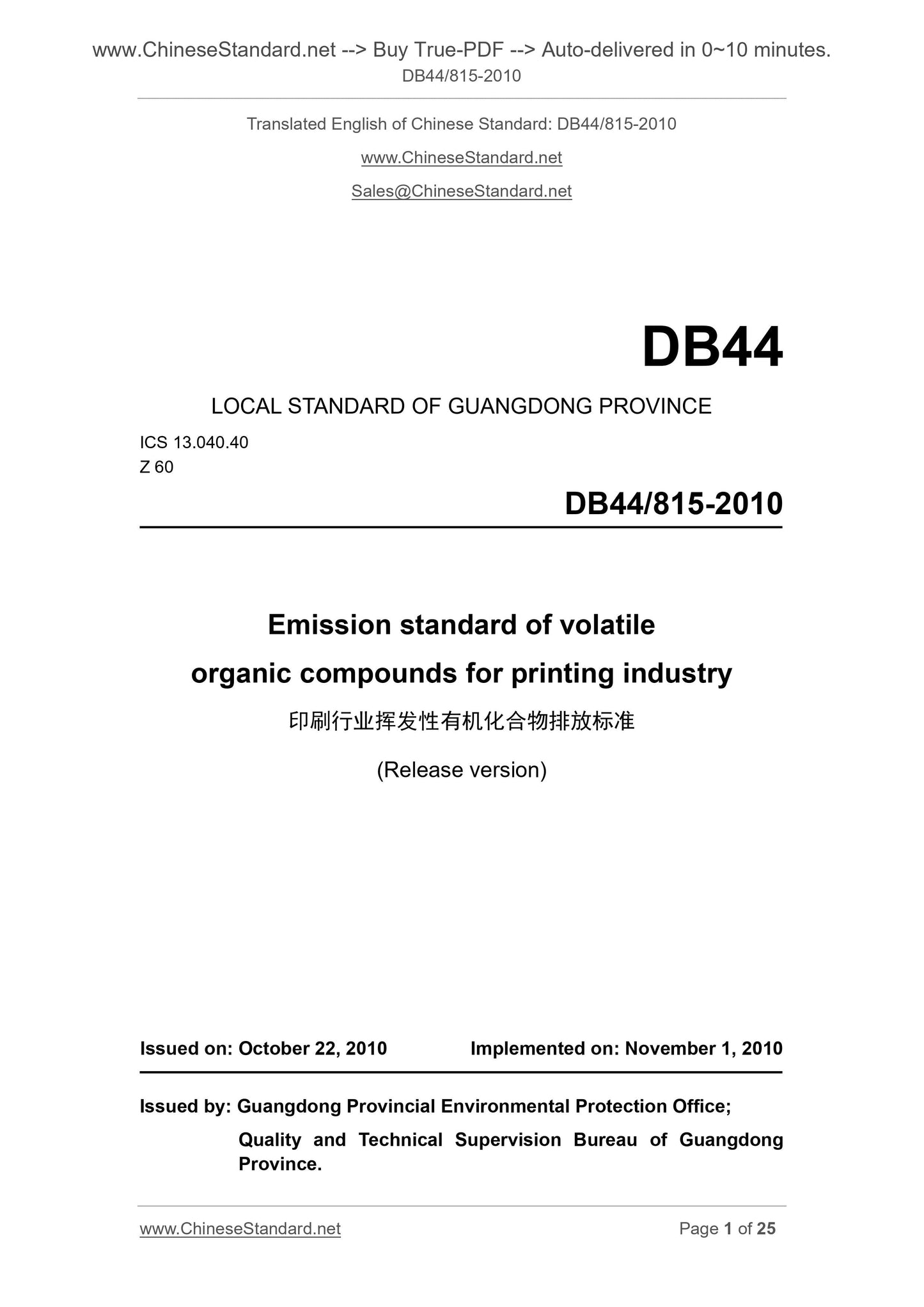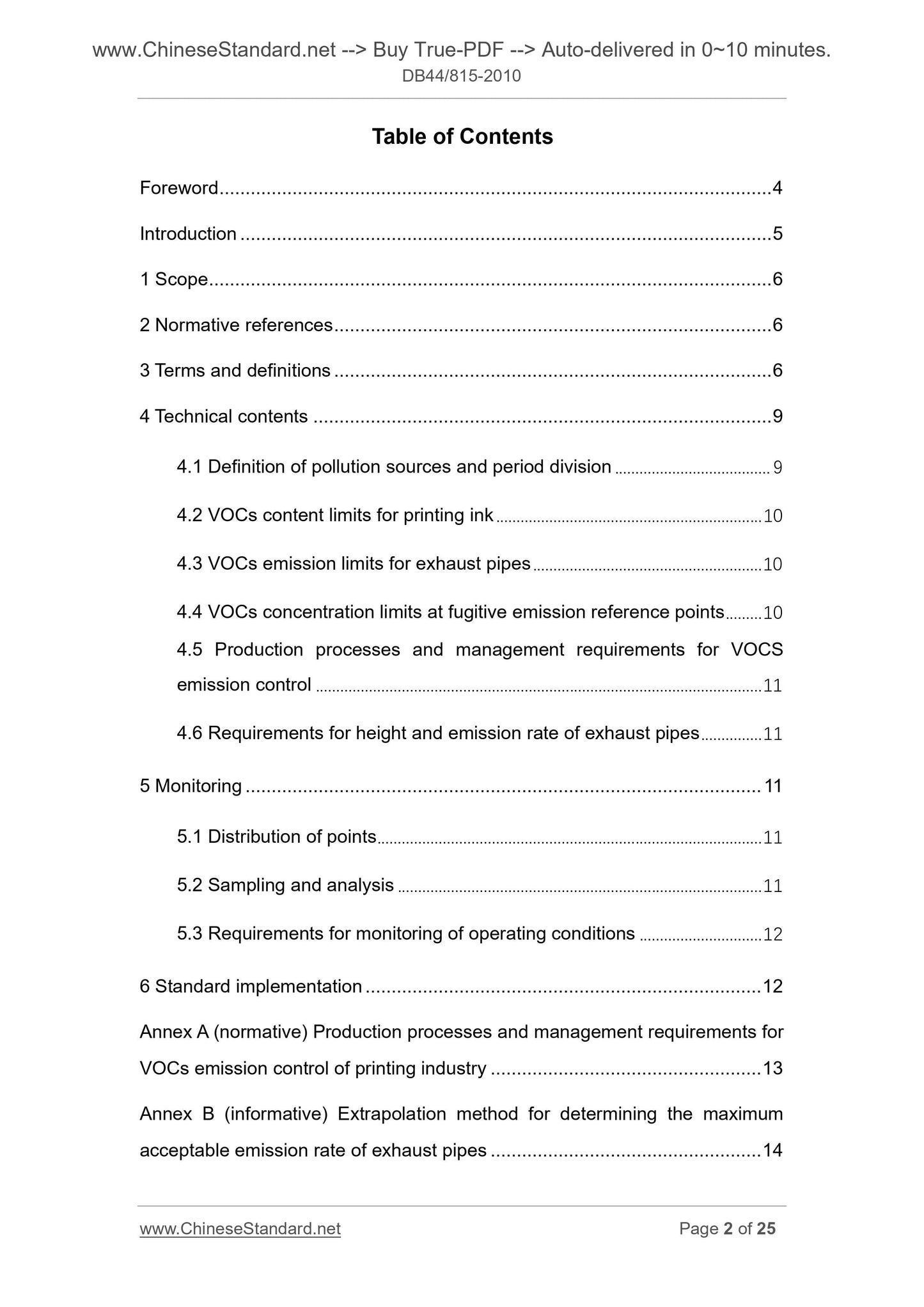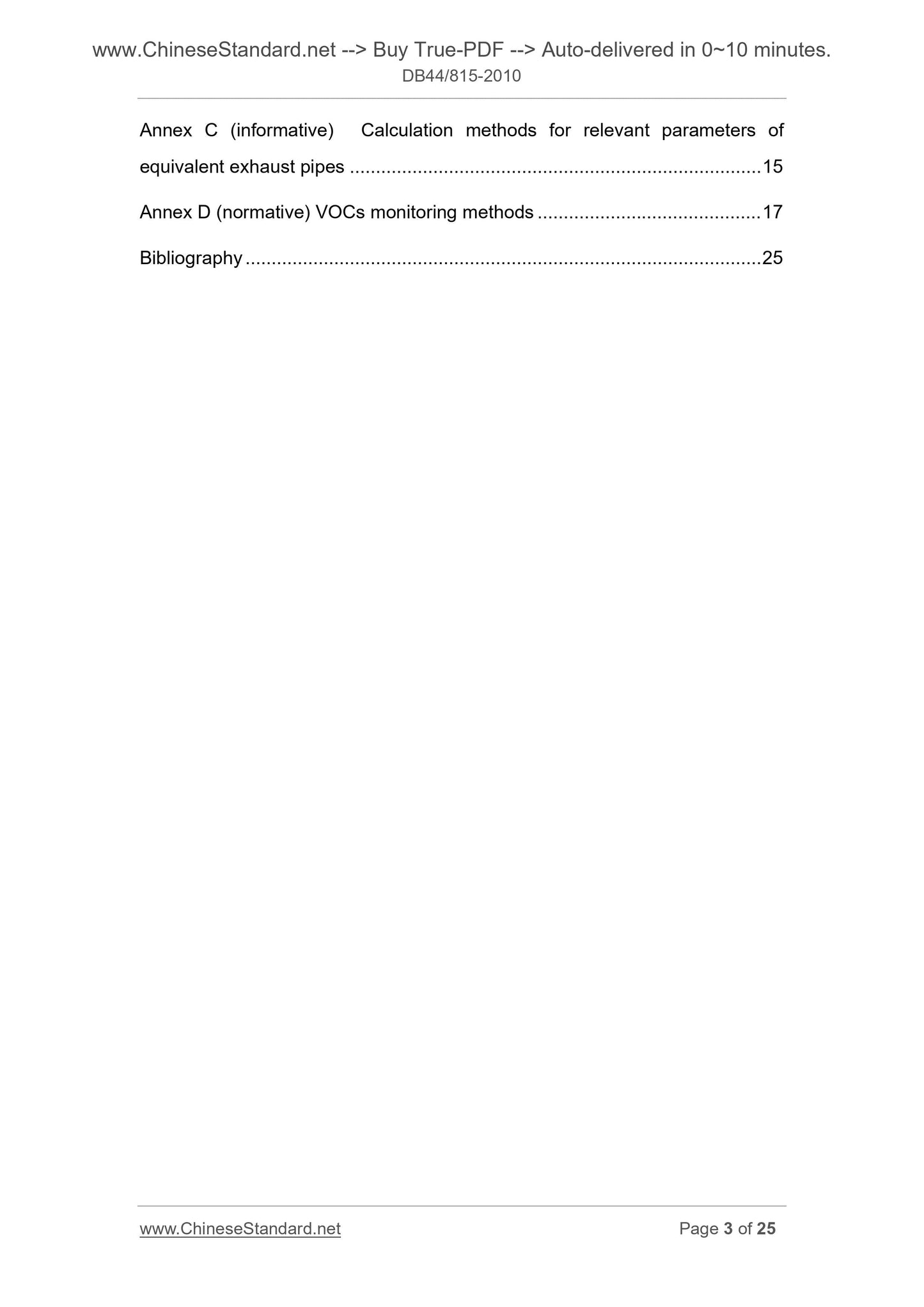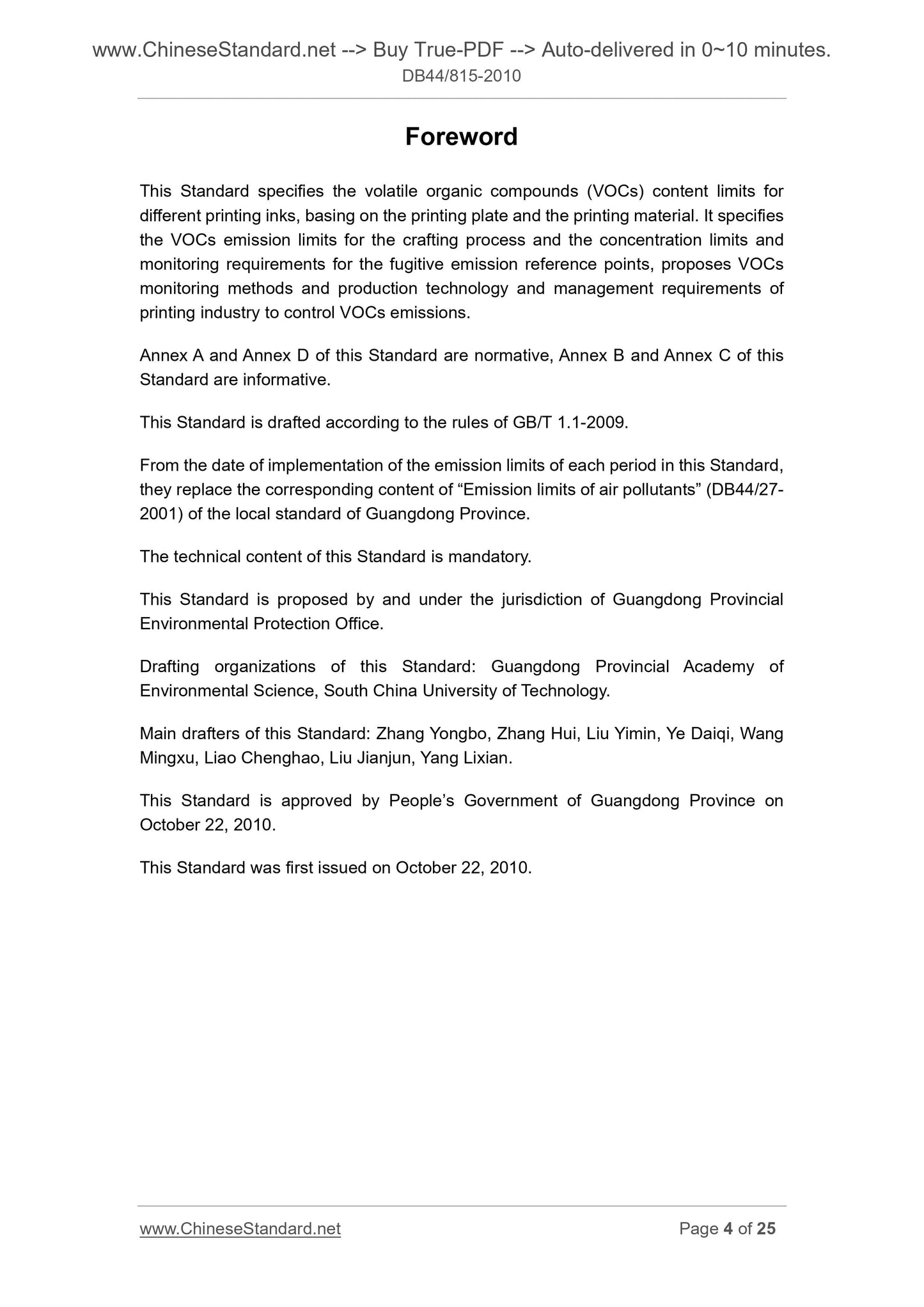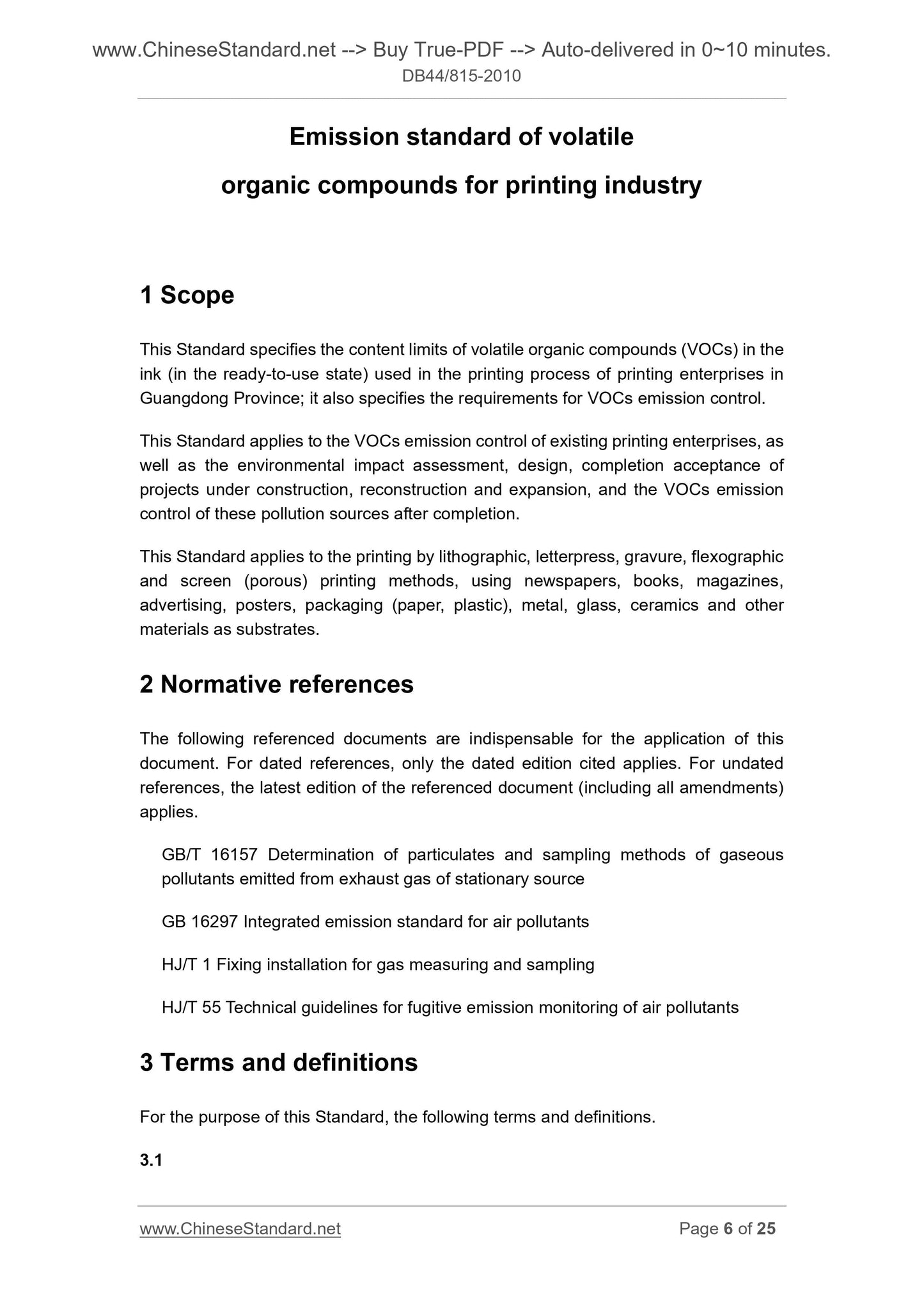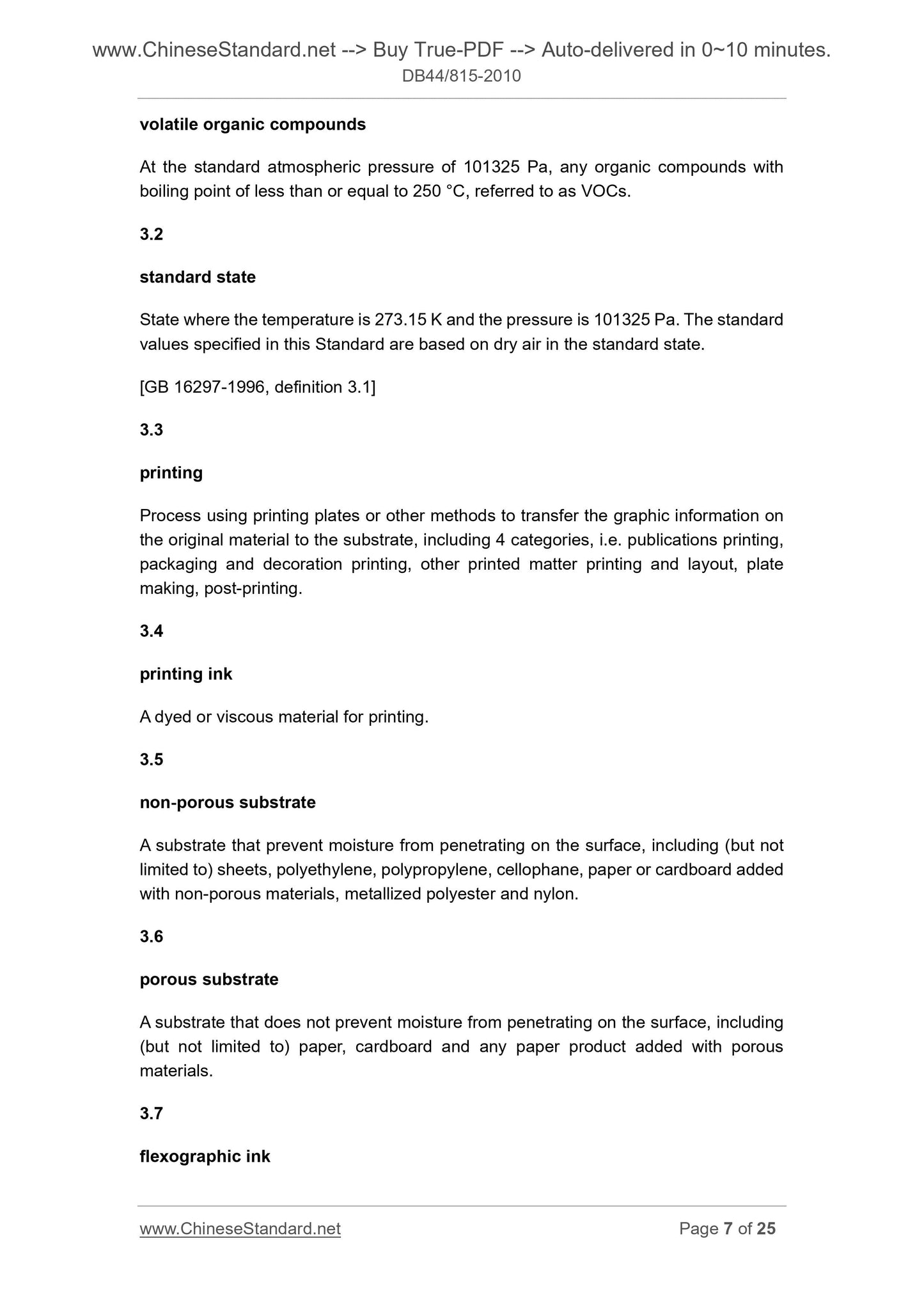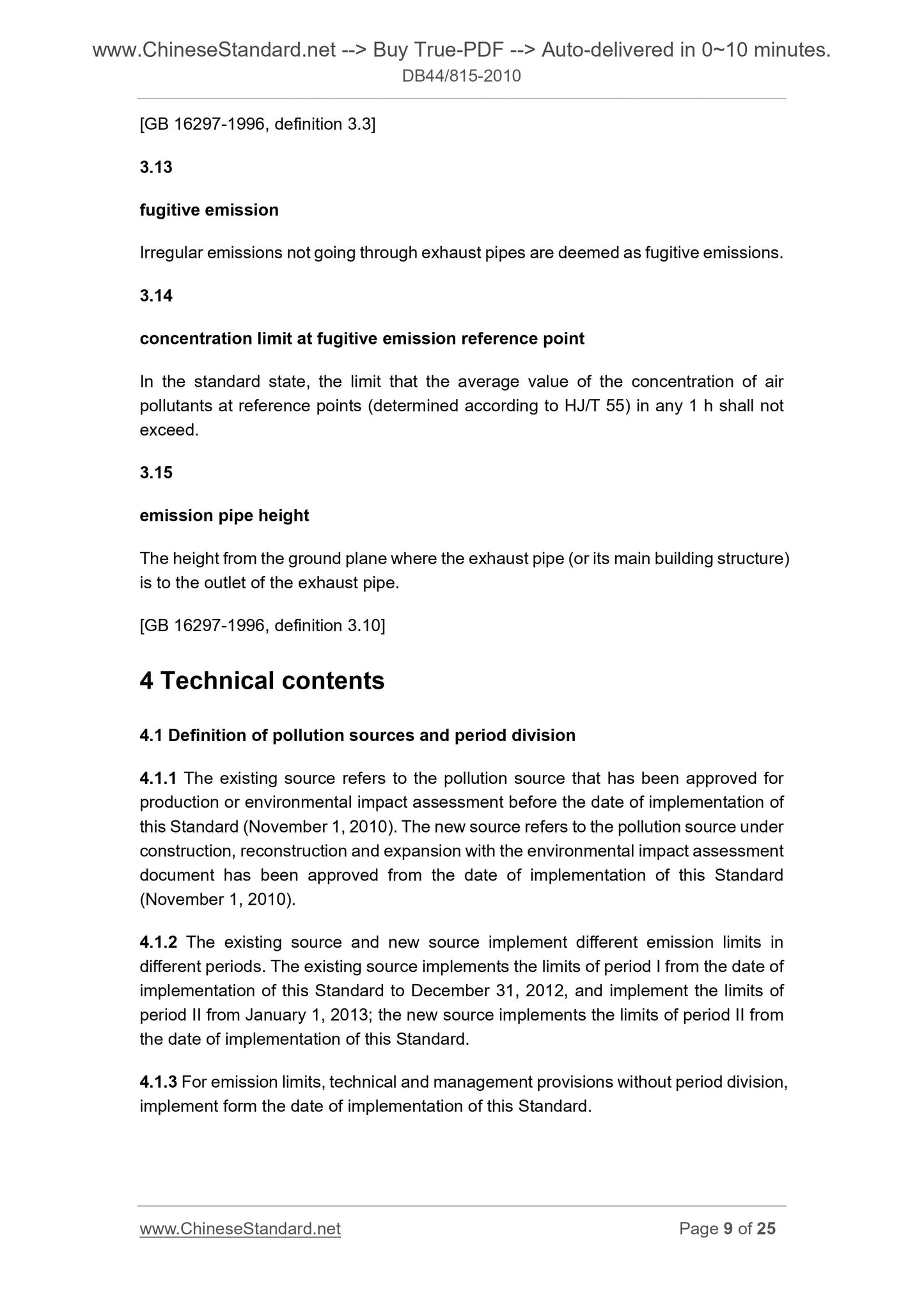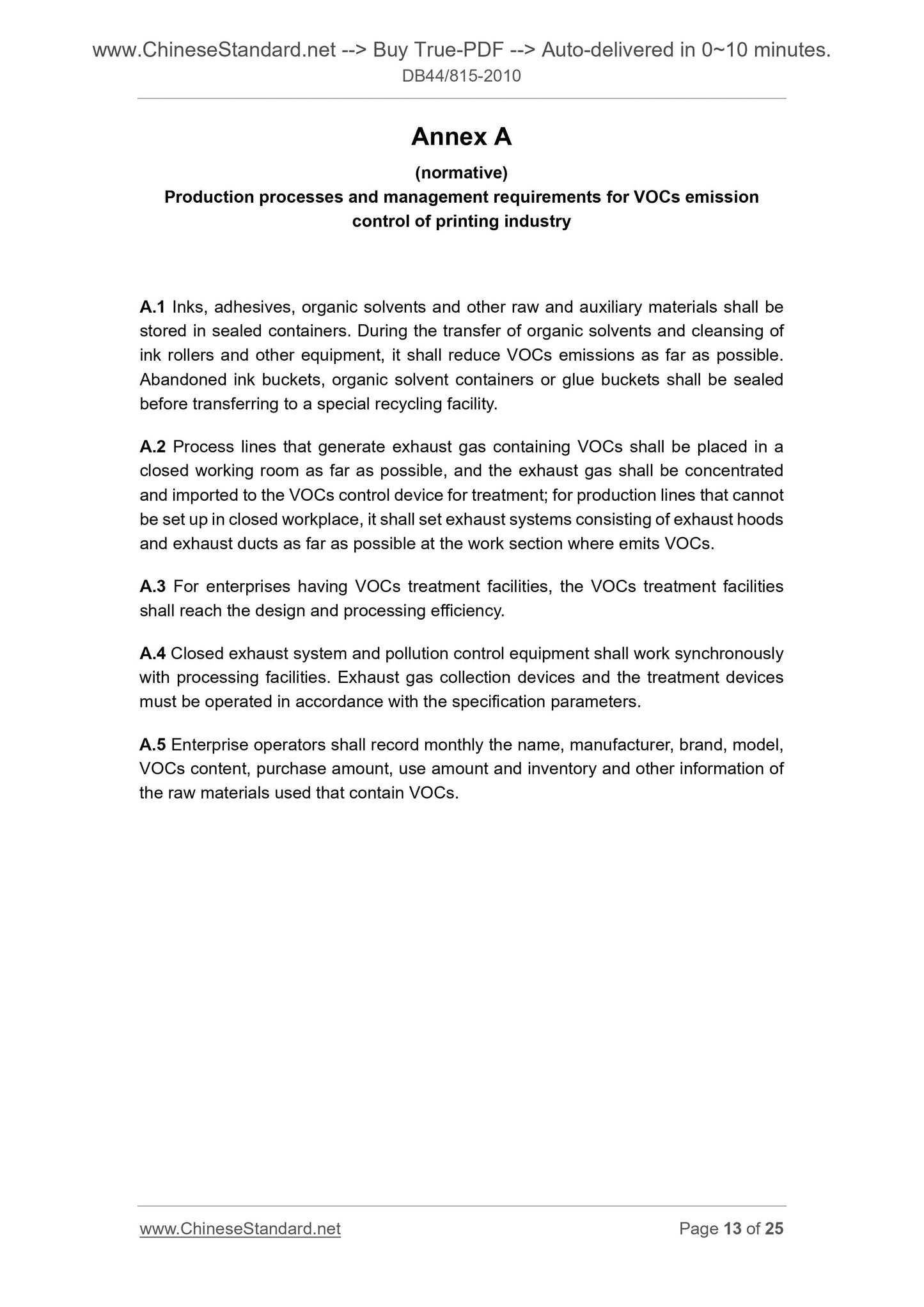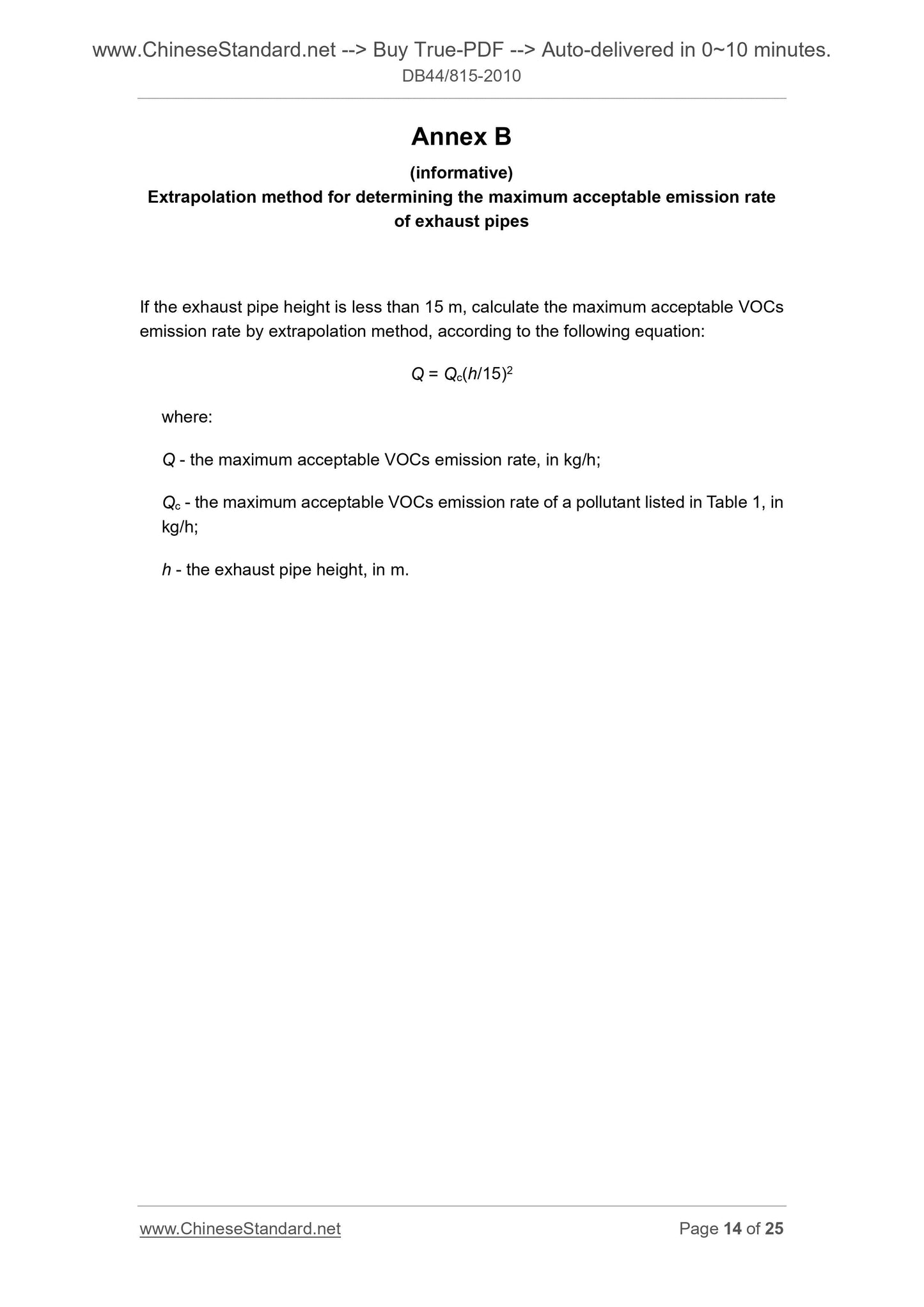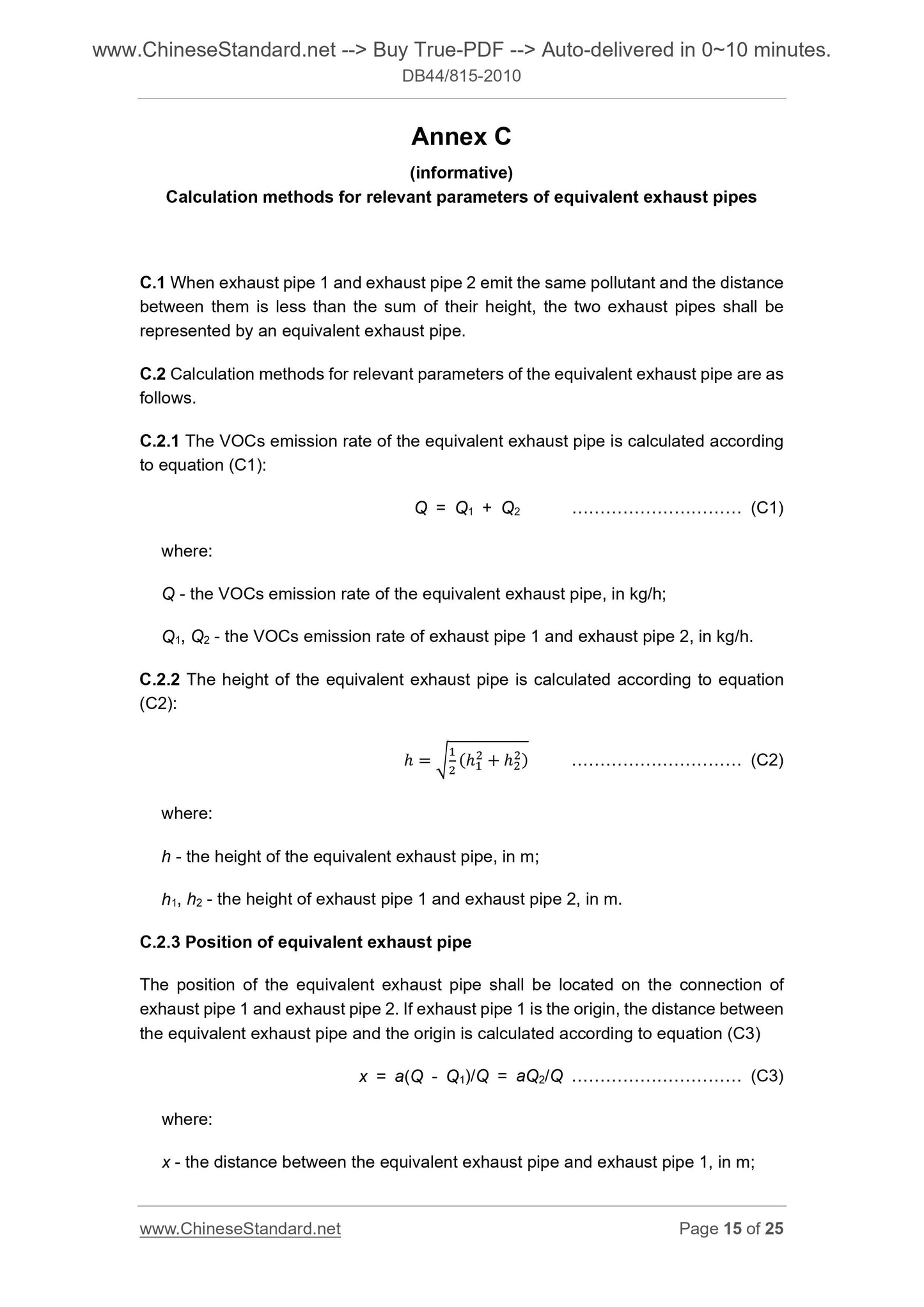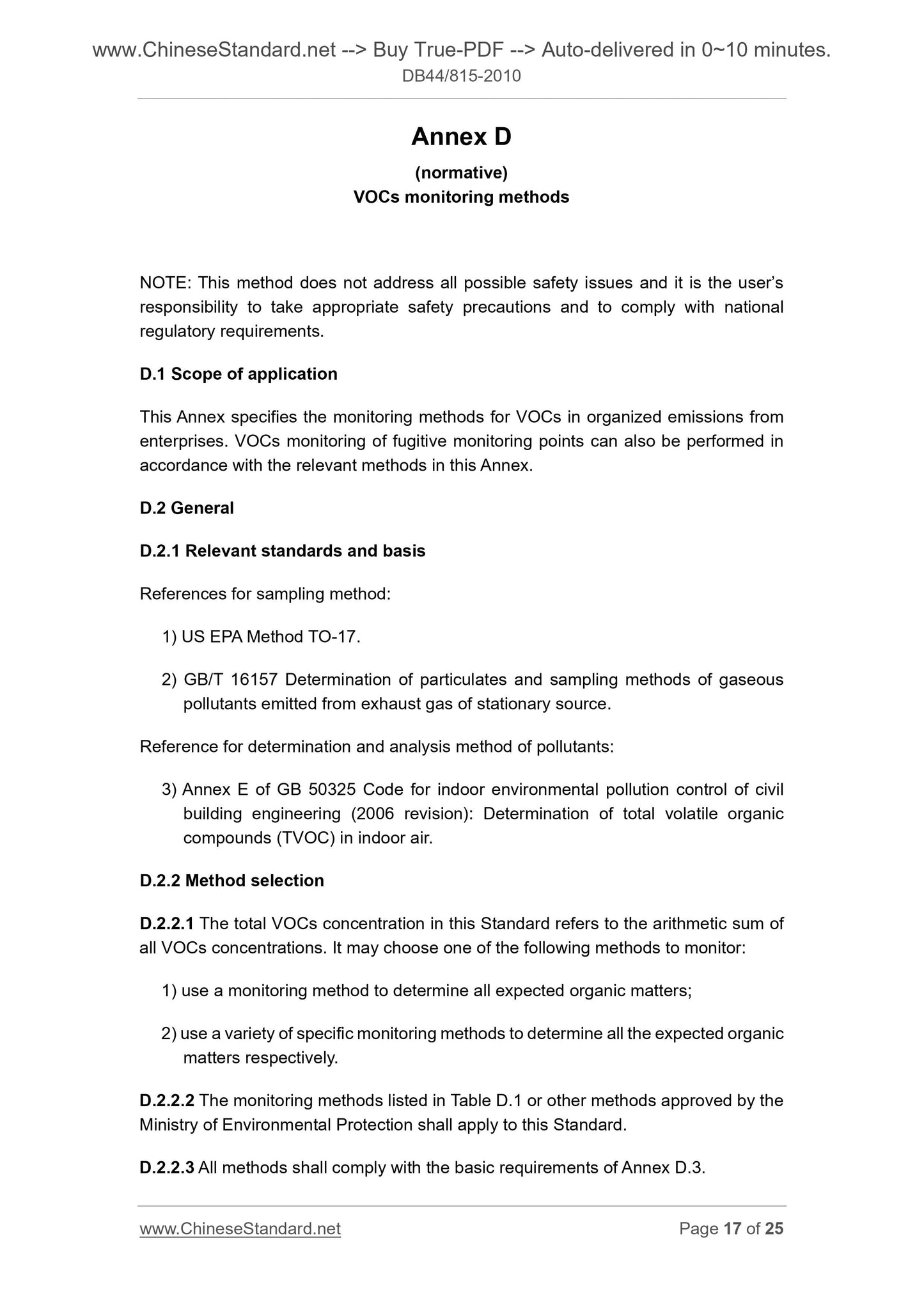1
/
の
12
PayPal, credit cards. Download editable-PDF and invoice in 1 second!
DB44/ 815-2010 English PDF (DB44815-2010)
DB44/ 815-2010 English PDF (DB44815-2010)
通常価格
$395.00 USD
通常価格
セール価格
$395.00 USD
単価
/
あたり
配送料はチェックアウト時に計算されます。
受取状況を読み込めませんでした
Delivery: 3 seconds. Download true-PDF + Invoice.
Get QUOTATION in 1-minute: Click DB44/815-2010
Historical versions: DB44/815-2010
Preview True-PDF (Reload/Scroll if blank)
DB44/815-2010:
DB44/815-2010
DB44
LOCAL STANDARD OF GUANGDONG PROVINCE
ICS 13.040.40
Z 60
Emission standard of volatile
organic compounds for printing industry
(Release version)
ISSUED ON. OCTOBER 22, 2010
IMPLEMENTED ON. NOVEMBER 1, 2010
Issued by. Guangdong Provincial Environmental Protection Office;
Quality and Technical Supervision Bureau of Guangdong
Province.
Table of Contents
Foreword ... 4
Introduction ... 5
1 Scope ... 6
2 Normative references ... 6
3 Terms and definitions ... 6
4 Technical contents ... 9
4.1 Definition of pollution sources and period division ... 9
4.2 VOCs content limits for printing ink ... 10
4.3 VOCs emission limits for exhaust pipes ... 10
4.4 VOCs concentration limits at fugitive emission reference points ... 10
4.5 Production processes and management requirements for VOCS
emission control ... 11
4.6 Requirements for height and emission rate of exhaust pipes ... 11
5 Monitoring ... 11
5.1 Distribution of points ... 11
5.2 Sampling and analysis ... 11
5.3 Requirements for monitoring of operating conditions ... 12
6 Standard implementation ... 12
Annex A (normative) Production processes and management requirements for
VOCs emission control of printing industry ... 13
Annex B (informative) Extrapolation method for determining the maximum
acceptable emission rate of exhaust pipes ... 14
Annex C (informative) Calculation methods for relevant parameters of
equivalent exhaust pipes ... 15
Annex D (normative) VOCs monitoring methods ... 17
Bibliography ... 25
Foreword
This Standard specifies the volatile organic compounds (VOCs) content limits for
different printing inks, basing on the printing plate and the printing material. It specifies
the VOCs emission limits for the crafting process and the concentration limits and
monitoring requirements for the fugitive emission reference points, proposes VOCs
monitoring methods and production technology and management requirements of
printing industry to control VOCs emissions.
Annex A and Annex D of this Standard are normative, Annex B and Annex C of this
Standard are informative.
This Standard is drafted according to the rules of GB/T 1.1-2009.
From the date of implementation of the emission limits of each period in this Standard,
they replace the corresponding content of “Emission limits of air pollutants” (DB44/27-
2001) of the local standard of Guangdong Province.
The technical content of this Standard is mandatory.
This Standard is proposed by and under the jurisdiction of Guangdong Provincial
Environmental Protection Office.
Drafting organizations of this Standard. Guangdong Provincial Academy of
Environmental Science, South China University of Technology.
Main drafters of this Standard. Zhang Yongbo, Zhang Hui, Liu Yimin, Ye Daiqi, Wang
Mingxu, Liao Chenghao, Liu Jianjun, Yang Lixian.
This Standard is approved by People’s Government of Guangdong Province on
October 22, 2010.
This Standard was first issued on October 22, 2010.
Emission standard of volatile
organic compounds for printing industry
1 Scope
This Standard specifies the content limits of volatile organic compounds (VOCs) in the
ink (in the ready-to-use state) used in the printing process of printing enterprises in
Guangdong Province; it also specifies the requirements for VOCs emission control.
This Standard applies to the VOCs emission control of existing printing enterprises, as
well as the environmental impact assessment, design, completion acceptance of
projects under construction, reconstruction and expansion, and the VOCs emission
control of these pollution sources after completion.
This Standard applies to the printing by lithographic, letterpress, gravure, flexographic
and screen (porous) printing methods, using newspapers, books, magazines,
advertising, posters, packaging (paper, plastic), metal, glass, ceramics and other
materials as substrates.
2 Normative references
The following referenced documents are indispensable for the application of this
document. For dated references, only the dated edition cited applies. For undated
references, the latest edition of the referenced document (including all amendments)
applies.
GB/T 16157 Determination of particulates and sampling methods of gaseous
pollutants emitted from exhaust gas of stationary source
GB 16297 Integrated emission standard for air pollutants
HJ/T 1 Fixing installation for gas measuring and sampling
HJ/T 55 Technical guidelines for fugitive emission monitoring of air pollutants
3 Terms and definitions
For the purpose of this Standard, the following terms and definitions.
3.1
volatile organic compounds
At the standard atmospheric pressure of 101325 Pa, any organic compounds with
boiling point of less than or equal to 250 °C, referred to as VOCs.
3.2
standard state
State where the temperature is 273.15 K and the pressure is 101325 Pa. The standard
values specified in this Standard are based on dry air in the standard state.
[GB 16297-1996, definition 3.1]
3.3
printing
Process using printing plates or other methods to transfer the graphic information on
the original material to the substrate, including 4 categories, i.e. publications printing,
packaging and decoration printing, other printed matter printing and layout, plate
making, post-printing.
3.4
printing ink
A dyed or viscous material for printing.
3.5
non-porous substrate
A substrate that prevent moisture from penetrating on the surface, including (but not
limited to) sheets, polyethylene, polypropylene, cellophane, paper or cardboard added
with non-porous materials, metallized polyester and nylon.
3.6
porous substrate
A substrate that does not prevent moisture from penetrating on the surface, including
(but not limited to) paper, cardboard and any paper product added with porous
materials.
3.7
flexographic ink
[GB 16297-1996, definition 3.3]
3.13
fugitive emission
Irregular emissions not going through exhaust pipes are deemed as fugitive emissions.
3.14
concentration limit at fugitive emission reference point
In the standard state, the limit that the average value of the concentration of air
pollutants at reference points (determined according to HJ/T 55) in any 1 h shall not
exceed.
3.15
emission pipe height
The height from the ground plane where the exhaust pipe (or its main building structure)
is to the outlet of the exhaust pipe.
[GB 16297-1996, definition 3.10]
4 Technical contents
4.1 Definition of pollution sources and period division
4.1.1 The existing source refers to the pollution source that has been approved for
production or environmental impact assessment before the date of implementation of
this Standard (November 1, 2010). The new source refers to the pollution source under
construction, reconstruction and expansion with the environmental impact assessment
document has been approved from the date of implementation of this Standard
(November 1, 2010).
4.1.2 The existing source and new source implement different emission limits in
different periods. The existing source implements the limits of period I from the date of
implementation of this Standard to December 31, 2012, and implement the limits of
period II from January 1, 2013; the new source implements the limits of period II from
the date of implementation of this Standard.
4.1.3 For emission limits, technical and mana...
Get QUOTATION in 1-minute: Click DB44/815-2010
Historical versions: DB44/815-2010
Preview True-PDF (Reload/Scroll if blank)
DB44/815-2010:
DB44/815-2010
DB44
LOCAL STANDARD OF GUANGDONG PROVINCE
ICS 13.040.40
Z 60
Emission standard of volatile
organic compounds for printing industry
(Release version)
ISSUED ON. OCTOBER 22, 2010
IMPLEMENTED ON. NOVEMBER 1, 2010
Issued by. Guangdong Provincial Environmental Protection Office;
Quality and Technical Supervision Bureau of Guangdong
Province.
Table of Contents
Foreword ... 4
Introduction ... 5
1 Scope ... 6
2 Normative references ... 6
3 Terms and definitions ... 6
4 Technical contents ... 9
4.1 Definition of pollution sources and period division ... 9
4.2 VOCs content limits for printing ink ... 10
4.3 VOCs emission limits for exhaust pipes ... 10
4.4 VOCs concentration limits at fugitive emission reference points ... 10
4.5 Production processes and management requirements for VOCS
emission control ... 11
4.6 Requirements for height and emission rate of exhaust pipes ... 11
5 Monitoring ... 11
5.1 Distribution of points ... 11
5.2 Sampling and analysis ... 11
5.3 Requirements for monitoring of operating conditions ... 12
6 Standard implementation ... 12
Annex A (normative) Production processes and management requirements for
VOCs emission control of printing industry ... 13
Annex B (informative) Extrapolation method for determining the maximum
acceptable emission rate of exhaust pipes ... 14
Annex C (informative) Calculation methods for relevant parameters of
equivalent exhaust pipes ... 15
Annex D (normative) VOCs monitoring methods ... 17
Bibliography ... 25
Foreword
This Standard specifies the volatile organic compounds (VOCs) content limits for
different printing inks, basing on the printing plate and the printing material. It specifies
the VOCs emission limits for the crafting process and the concentration limits and
monitoring requirements for the fugitive emission reference points, proposes VOCs
monitoring methods and production technology and management requirements of
printing industry to control VOCs emissions.
Annex A and Annex D of this Standard are normative, Annex B and Annex C of this
Standard are informative.
This Standard is drafted according to the rules of GB/T 1.1-2009.
From the date of implementation of the emission limits of each period in this Standard,
they replace the corresponding content of “Emission limits of air pollutants” (DB44/27-
2001) of the local standard of Guangdong Province.
The technical content of this Standard is mandatory.
This Standard is proposed by and under the jurisdiction of Guangdong Provincial
Environmental Protection Office.
Drafting organizations of this Standard. Guangdong Provincial Academy of
Environmental Science, South China University of Technology.
Main drafters of this Standard. Zhang Yongbo, Zhang Hui, Liu Yimin, Ye Daiqi, Wang
Mingxu, Liao Chenghao, Liu Jianjun, Yang Lixian.
This Standard is approved by People’s Government of Guangdong Province on
October 22, 2010.
This Standard was first issued on October 22, 2010.
Emission standard of volatile
organic compounds for printing industry
1 Scope
This Standard specifies the content limits of volatile organic compounds (VOCs) in the
ink (in the ready-to-use state) used in the printing process of printing enterprises in
Guangdong Province; it also specifies the requirements for VOCs emission control.
This Standard applies to the VOCs emission control of existing printing enterprises, as
well as the environmental impact assessment, design, completion acceptance of
projects under construction, reconstruction and expansion, and the VOCs emission
control of these pollution sources after completion.
This Standard applies to the printing by lithographic, letterpress, gravure, flexographic
and screen (porous) printing methods, using newspapers, books, magazines,
advertising, posters, packaging (paper, plastic), metal, glass, ceramics and other
materials as substrates.
2 Normative references
The following referenced documents are indispensable for the application of this
document. For dated references, only the dated edition cited applies. For undated
references, the latest edition of the referenced document (including all amendments)
applies.
GB/T 16157 Determination of particulates and sampling methods of gaseous
pollutants emitted from exhaust gas of stationary source
GB 16297 Integrated emission standard for air pollutants
HJ/T 1 Fixing installation for gas measuring and sampling
HJ/T 55 Technical guidelines for fugitive emission monitoring of air pollutants
3 Terms and definitions
For the purpose of this Standard, the following terms and definitions.
3.1
volatile organic compounds
At the standard atmospheric pressure of 101325 Pa, any organic compounds with
boiling point of less than or equal to 250 °C, referred to as VOCs.
3.2
standard state
State where the temperature is 273.15 K and the pressure is 101325 Pa. The standard
values specified in this Standard are based on dry air in the standard state.
[GB 16297-1996, definition 3.1]
3.3
printing
Process using printing plates or other methods to transfer the graphic information on
the original material to the substrate, including 4 categories, i.e. publications printing,
packaging and decoration printing, other printed matter printing and layout, plate
making, post-printing.
3.4
printing ink
A dyed or viscous material for printing.
3.5
non-porous substrate
A substrate that prevent moisture from penetrating on the surface, including (but not
limited to) sheets, polyethylene, polypropylene, cellophane, paper or cardboard added
with non-porous materials, metallized polyester and nylon.
3.6
porous substrate
A substrate that does not prevent moisture from penetrating on the surface, including
(but not limited to) paper, cardboard and any paper product added with porous
materials.
3.7
flexographic ink
[GB 16297-1996, definition 3.3]
3.13
fugitive emission
Irregular emissions not going through exhaust pipes are deemed as fugitive emissions.
3.14
concentration limit at fugitive emission reference point
In the standard state, the limit that the average value of the concentration of air
pollutants at reference points (determined according to HJ/T 55) in any 1 h shall not
exceed.
3.15
emission pipe height
The height from the ground plane where the exhaust pipe (or its main building structure)
is to the outlet of the exhaust pipe.
[GB 16297-1996, definition 3.10]
4 Technical contents
4.1 Definition of pollution sources and period division
4.1.1 The existing source refers to the pollution source that has been approved for
production or environmental impact assessment before the date of implementation of
this Standard (November 1, 2010). The new source refers to the pollution source under
construction, reconstruction and expansion with the environmental impact assessment
document has been approved from the date of implementation of this Standard
(November 1, 2010).
4.1.2 The existing source and new source implement different emission limits in
different periods. The existing source implements the limits of period I from the date of
implementation of this Standard to December 31, 2012, and implement the limits of
period II from January 1, 2013; the new source implements the limits of period II from
the date of implementation of this Standard.
4.1.3 For emission limits, technical and mana...
Share
